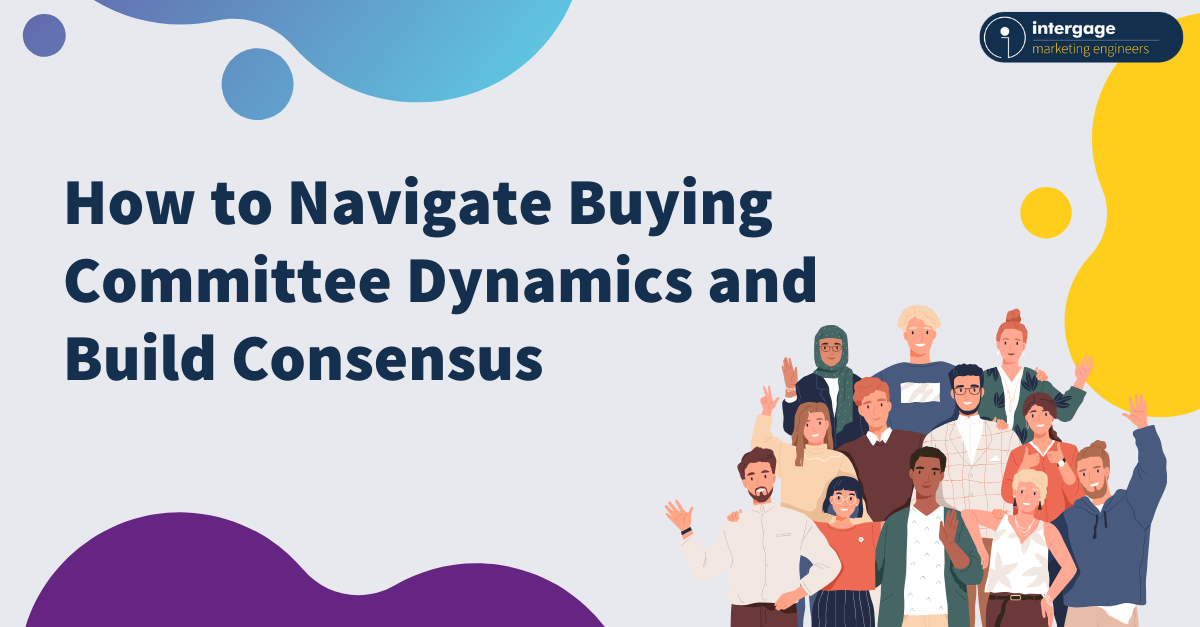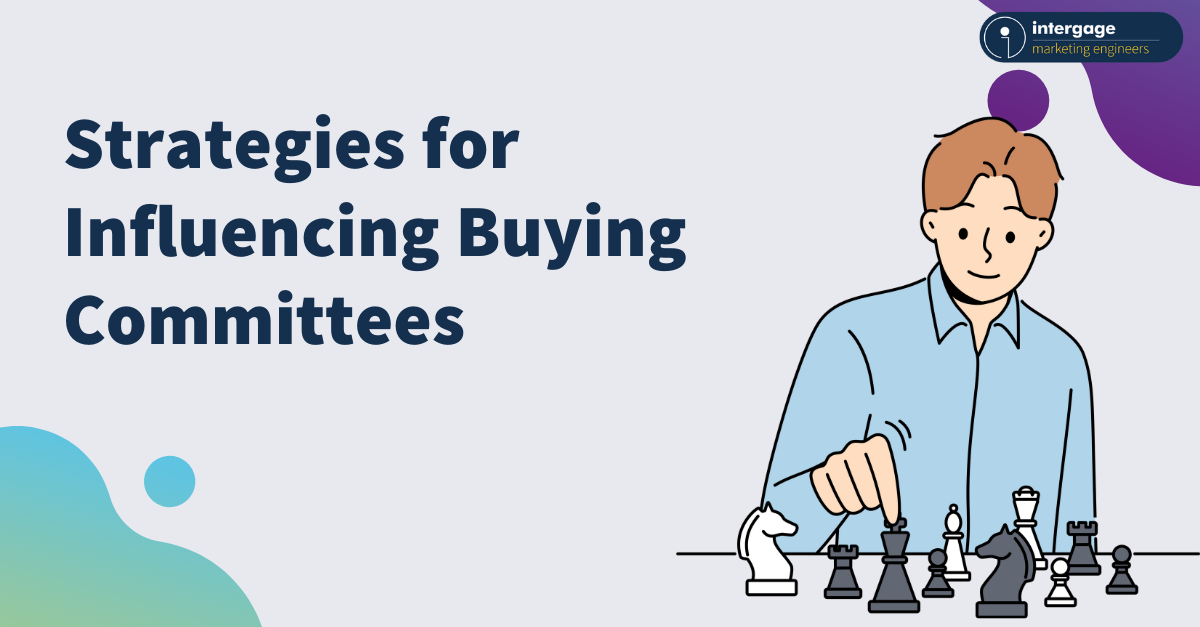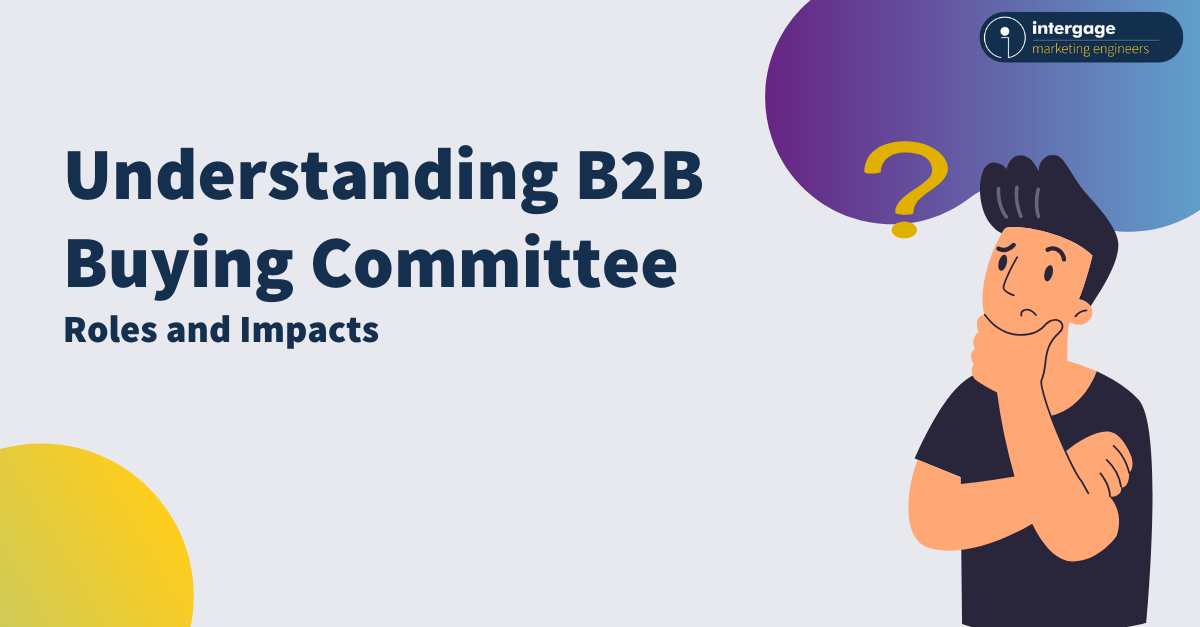A buying committee refers to a group of individuals within an organisation who are involved in the decision-making process for purchasing a product or service. This committee typically consists of various stakeholders who play different roles and have distinct responsibilities in the procurement process.
Understanding the buying committee in B2B sales and marketing is crucial because it enables businesses to navigate complex decision-making processes, tailor their messaging to diverse stakeholders, build consensus, proactively address objections, allocate resources efficiently, gain a competitive edge, and ultimately increase the likelihood of successful sales.
Who makes up the B2B buying committee?
As mentioned in our buyer enablement guide, the typical buying committee is made up of the following members:
- The champion – A champion is an individual who actively supports and advocates for a particular product, service, or solution being considered for purchase. This person plays a pivotal role in the decision-making process by promoting the offering within their organisation, working to overcome objections or obstacles, and influencing other members of the buying team to support the choice. Champions are typically enthusiastic about the solution and are crucial in helping the selling organisation navigate and succeed in the complex B2B sales landscape.
- The decision maker – The decision maker is the individual with the ultimate authority and responsibility for making the final decision on whether to purchase a product, service, or solution. This person holds the power to approve or reject the proposed purchase and often has the authority to allocate budget resources. The decision maker's role is critical in the buying process, as their approval is necessary to move forward with the purchase. They may also consult with other members of the buying team, but the final decision rests with them.
- The influencer – An influencer is an individual who wields influence and can impact the decision-making process, even though they may not have the final decision-making authority. Influencers often have subject matter expertise, experience, or credibility in a specific area relevant to the purchase. They provide valuable insights and recommendations that can shape the opinions of the decision maker. While they don't make the final decision, their input is highly regarded and can significantly influence the outcome of the buying process.
- The blocker – A blocker is an individual or stakeholder who opposes or raises objections to a proposed purchase, potentially impeding or delaying the decision-making process. Blockers may have concerns about the product, service, or solution being considered, budget constraints, organisational politics, or other issues that lead them to resist or challenge the decision. Identifying and addressing the concerns of blockers is essential to overcoming obstacles in the buying process and achieving consensus within the team.
What are the dynamics between different members of the buying committee?
The dynamics among members of a B2B buying committee are inherently complex due to the diversity of roles, interests, motivations, and power dynamics within the group. Each committee member brings a unique perspective and set of responsibilities, which can result in conflicting priorities and viewpoints. Varying levels of authority and expertise further complicate the dynamics, as some members may hold more sway over the decision-making process than others. These complexities can lead to communication challenges, conflicts, and internal politics within the committee.
These intricate dynamics have a direct impact on the committee's ability to make buying decisions. The diversity of perspectives and interests can lead to prolonged deliberations, as members must navigate differences and reach a consensus. The presence of blockers or conflicting influencers can impede the decision-making process, potentially causing delays or even preventing a decision altogether. Effective vendor engagement and sales strategies that address these complexities are crucial to guide the committee toward a successful purchase. Ultimately, understanding and managing these dynamics is essential for vendors aiming to influence and support the B2B buying committee in reaching a positive decision.
The below should give you some idea of the dynamics between the individual committee members.
Key:
++ strong positive relationship
+ positive relationship
0 neutral/indifferent relationship
- Negative relationship
-- Strong negative relationship
|
|
Decision maker |
Champion |
Influencer |
Blocker |
|
Decision maker |
|
Allies (+) |
Influenced (+) |
Conflict (--) |
|
Champion |
Allies (+) |
|
Supportive (++) |
Potential conflict (-) |
|
Influencer |
Influenced (+) |
Supportive (++) |
|
Opposition (--) |
|
Blocker |
Conflict (--) |
Potential conflict (-) |
Opposition (--) |
|
The buying committee does not replace your marketing personas
A common misconception is that the buying committee methodology replaces marketing personas which simply isn’t true. They should be used in tandem with each other to build up a clear picture of what individual buying teams look like and the motives of people within those teams.
Typically, the buying committee is made up of several personas but different personas may have different buying committee roles in individual businesses.
For example, Sam the sales director might be the champion for your product in one business, but the decision maker in another. Likewise, Paul the procurement officer might be the blocker in one business but the influencer in another. The make-up of personas and buying committee members will be completely individual to each business.
That said, you can certainly start to build up a picture of what a typical champion, influencer, blocker and decision maker looks like by reviewing your current customer base and interviewing you customers to find out more about their buying experience with you and who was involved in that process.
What are the challenges of selling into a buying committee?
Influencing and aligning a diverse buying committee presents intricate challenges for B2B sellers, and these challenges have significant implications for closing sales and meeting sales targets. One of the primary challenges lies in the differing interests within the committee. Each member typically brings distinct priorities and motivations to the table, such as cost savings, product features, or operational efficiency. Sellers must craft a value proposition that speaks to these varied interests, which can be a difficult challenge.
Another challenge is the varying levels of influence wielded by committee members. While the ultimate decision maker holds the authority, others may have substantial sway due to their expertise or roles. Striking the right balance between gaining support from influencers and securing approval from the decision maker is often complex. Effective communication is paramount, yet different communication styles and preferences among committee members can lead to misunderstandings and misalignments. Navigating these communication gaps demands adaptability and tailored messaging.
Conflict resolution is another key hurdle. Disagreements and internal conflicts within the committee can stall the decision-making process or derail it entirely. Sellers must possess the skills to mediate discussions and guide the committee toward resolutions that favor their offering. Additionally, some committee members may actively resist or object to the proposed purchase, functioning as potential roadblocks. Persuading these individuals and garnering their support is critical for progress.
Consensus building is yet another challenge. Achieving unanimous agreement among diverse committee members is often time-consuming and may necessitate compromise. Sellers must adeptly navigate this process while ensuring their solution aligns with the majority's needs. Addressing information imbalances is crucial too, as not all committee members possess the same level of knowledge about the product or solution. Sellers must bridge this knowledge gap by delivering relevant insights tailored to each member's role.
Navigating organisational politics and power dynamics is an additional layer of complexity. Sellers must be mindful of hidden agendas or alliances among committee members that can sway decision-making. In a competitive landscape, different vendors may vie for the committee's attention, intensifying the challenge. Sellers must effectively differentiate their offerings and substantiate their superiority.
Lastly, adaptability is essential. Committee dynamics can evolve due to external factors or changing organisational priorities. Sellers must remain agile and capable of navigating shifting dynamics while maintaining their influence. In successfully addressing these multifaceted challenges, B2B sellers can significantly enhance their ability to close sales and meet sales targets in the dynamic and competitive B2B sales arena.
Influencing and engaging with the buying committee
How to build a relationship with the champion in the buying committee?
The likelihood is, the champion will be the easiest person for you to build a relationship with. They’re already on-board and are probably going to be one of the end users of your product/service. They have the biggest problem to solve and so are going to be relatively easy to win over. However, the stronger relationship you can build the better. Especially as you may not be the only potential supplier they’re speaking to.
There are some tactics we know to work particularly well when connecting with a champion:
- Engage Early and Consistently: Initiate contact with the champion early in the sales process and maintain consistent communication. Provide updates, share relevant content, and offer value to keep them engaged.
- Understand Their Goals and Pain Points: Take the time to understand the champion's specific goals, challenges, and objectives within their organisation. Tailor your messaging to demonstrate how your solution can address their needs.
- Provide Educational Resources: Offer educational content and resources that empower the champion to become an expert on your solution. This can include whitepapers, case studies, webinars but also more interactive content such as ROI calculators, self-diagnosis tools and simulators.
- Leverage Their Insights: Encourage the champion to share their insights and perspectives with the buying committee. Their endorsement can carry significant weight in the decision-making process. It might even be worth providing them with support on how to position your solution to the rest of the committee.
- Build Trust and Credibility: Demonstrate your trustworthiness and credibility through transparent communication, fulfilling promises, and consistently delivering value. Trust is the foundation of a strong relationship.
- Share Success Stories: Share success stories and testimonials from similar organisations that have benefited from your solution. This provides social proof and reinforces the champion's advocacy.
Essentially, you need to become best friends with your champion by understanding their world and providing them with the resources and counsel to help win over the rest of the buying committee.
When it comes to creating content that the champion will resonate with, you should consider that champions are enthusiastic supporters of your solution. Tailor messaging to emphasise how the solution aligns with their department's goals and their personal success. The types of content you should consider for champions include:
- In-depth case studies specific to their role, highlighting successful outcomes.
- Product demonstrations and access to user communities or peer networks for sharing experiences.
- Personalised success stories that showcase how their advocacy can drive positive change.
How to connect with the decision-maker in a buying committee?
It goes without saying that building a relationship with the decision-maker should be a priority. This is the person that ultimately has the say on whether or not you’re chosen as a supplier. So, how can you connect and build a relationship with them?
- Identify Their Needs and Priorities: Start by understanding the decision maker's specific needs, goals, and priorities. Tailor your messaging to demonstrate how your solution aligns with these objectives.
- Offer High-Value Insights: Provide decision makers with valuable industry insights, market trends, and data that can inform their strategic decisions. Position yourself as a trusted source of information and someone who adds value to their business.
- Demonstrate ROI and Value: Clearly articulate how your solution delivers a strong return on investment (ROI) and quantifiable value. Use case studies, ROI calculators, and business impact assessments to illustrate these benefits.
- Leverage Trusted Relationships: If you have trusted relationships with influencers or champions within the organisation, leverage these connections to gain access to decision makers. Recommendations from respected colleagues can carry weight. Equally, review if you have mutual connections with people outside of their organisation.
- Ensure Smooth Implementation: Assure the decision maker that your team is committed to a seamless implementation process. Highlight your track record of successful implementations and customer satisfaction while demonstrating you have documented evidence of what that process looks like. Providing them with insight into what it’s like working with you will allow them to visualise how your solution will look for them and minimise any fears they have.
- Address Risk and Compliance: Understand the decision maker's concerns about risk, compliance, and security. Be prepared to provide detailed information about your solution's security measures and compliance standards.
- Provide References and Testimonials: Offer references and testimonials from other organisations with similar challenges or objectives. Peer endorsements can bolster confidence in your solution.
This could be one of the most important relationships you build in the selling process. The decision-maker will likely have the most questions for you as they are ultimately the ones risking making the wrong decision.
So, what types of content should you consider for the decision-maker? Decision makers are typically focused on the high-level impact of a purchase on their organisation. To resonate with them, messaging should emphasise the strategic benefits and alignment with business goals. Types of content that can appeal to decision makers include:
- Executive summaries that provide a concise overview of the solution's strategic advantages.
- ROI calculators and business impact reports that demonstrate the financial benefits.
- Strategic case studies showcasing how similar organisations achieved their objectives with your solution.
How to connect with the influencer in a buying committee?
While you may not have a huge amount of time with the influencer within the buying committee, it’s still paramount to build some kind of relationship with them. Their experience and influence internally within the prospective business could have the power to make or break the deal. Here are some ways you can build a relationship with the all-important influencer:
- Offer Expertise and Insights: Position yourself as a subject matter expert in your industry or domain. Provide valuable insights and knowledge that resonate with the influencer's interests.
- Engage in Thought Leadership: Share thought leadership content, such as articles, reports, and webinars, that showcases your industry expertise and provides value to the influencer.
- Foster Two-Way Communication: Encourage open and collaborative discussions with the influencer. Actively seek their input and opinions and listen to their feedback.
- Provide Easy Access to Information: Ensure that the influencer has easy access to product information, resources, and documentation. This streamlines their research and decision-making process.
- Collaborate on Presentations: Collaborate with the influencer on presentations or proposals to the buying committee. Their input and endorsement can carry significant weight.
- Offer Training and Resources: Provide training sessions or resources to help the influencer and their team maximise the value of your solution.
- Express Gratitude: Show appreciation for the influencer's support and efforts on your behalf. Thank them for their contributions to the decision-making process.
Building a strong relationship with the influencer involves demonstrating value, providing tailored support, and fostering open communication. By aligning your efforts with the influencer's interests and needs, you can gain their support and significantly impact the B2B buying decision.
If you’re looking to create content for an influencer, consider that they often have technical expertise and are concerned with solution functionality and integration. Messaging should address technical features and seamless integration with existing systems. Content that resonates with influencers includes:
- Technical documentation, specifications, and integration guides.
- Access to product experts and technical support channels.
- Interactive product simulations and hands-on technical demos to explore capabilities.
How to connect with the blocker in a buying committee?
This one is by far the most tricky. The likelihood is, the blocker actively doesn’t want to talk to you about your solutions. This could be for many reasons – they might feel they are under threat with your solutions, they may have had bad experiences in the past or they simply may not understand the value of your products and services. Whatever it is, you still need to try and build a relationship with them, understand their concerns and try and debunk their objections. Here’s how:
- Active Listening: Start by listening actively to understand the blocker's objections and concerns fully. Let them express their viewpoint and demonstrate that you value their input.
- Seek Common Ground: Identify common ground or shared goals between your solution and the blocker's objectives. Emphasise areas where your offering aligns with their interests.
- Provide Solutions, Not Arguments: Avoid confrontations or arguments. Instead, focus on providing solutions or addressing the specific issues raised by the blocker. Position yourself as a problem solver.
- Highlight Mitigations: Address the blocker's concerns by highlighting how your solution includes mitigations or measures to alleviate potential risks or challenges. Actively try and debunk their common objections, offering proof where possible.
- Engage Neutral Third Parties: If possible, involve neutral third parties, such as industry experts or consultants, to provide objective assessments or recommendations that may resonate with the blocker.
- Offer Trials or Pilots: Suggest a trial or pilot program that allows the blocker to evaluate your solution with minimal commitment and risk. This can help mitigate concerns.
While it may be difficult, there are small steps you can take to build a relationship with the blocker. In terms of content, tailored messaging should directly confront objections and provide solutions or mitigations. Content that can engage blockers effectively includes:
- Objection-handling guides that address common concerns and objections.
- Testimonials and case studies that highlight how similar objections were resolved.
- Free trials, pilots, or interactive self-diagnosis tools that alleviate concerns about risk and allow them to explore potential solutions.
The importance of addressing the concerns of the buying committee
When it comes to generating content for the buying committee, it can be tempting to shy away from the difficult questions they ask about alternative service providers, the potential for failure or previous bad experiences your committee may have had.
The reality is, if you don’t talk about these things head-on, they will find the information elsewhere and unfortunately, this means you have less control of the narrative.
You need to ensure you’re actively talking about other alternatives and how you match up. Where are the weak points in these alternatives and where does the value lie? You might consider doing a comparison chart to make this information easily digestible.
Equally, openly discuss the potential for failure, how it can be avoided and how to minimise impact where possible. Your prospects will be much more likely to buy from you if you’re open, honest and can present them with a plan of action.
These can all be difficult things to talk about, but being up-front, honest and open about these objections will help you build trust, remove friction in the buying process and mitigate understandings.
How to navigate complex buying committee dynamics
Conflicting interests within buying committees in the B2B sales process can introduce complexities and challenges that impact decision-making and the overall sales cycle. One common challenge is the difficulty in reaching a consensus among committee members with divergent priorities and viewpoints. These conflicting interests may stem from varying departmental goals, budget constraints, or personal motivations. As a result, finding common ground and aligning the committee around a singular decision can be challenging.
The process of reaching consensus can significantly prolong B2B sales cycles. Committee members may engage in extensive discussions, evaluations, and negotiations to reconcile their differences. This can lead to extended timelines as each member seeks to ensure their interests and concerns are adequately addressed. In some cases, the sheer number of opinions and viewpoints can create decision paralysis, where committee members become indecisive or hesitant to commit to a particular solution. Decision paralysis not only prolongs the sales cycle but also poses the risk of the deal stalling or falling through altogether.
Moreover, the presence of conflicting interests within the committee can lead to decisions not being made at all. When committee members are unable to reach a consensus or when conflicting interests become insurmountable, the organisation may opt to postpone or abandon the decision. This can be frustrating for both sellers and buyers, as significant time and resources may have been invested in the sales process, only to result in a non-decision.
Want to learn more? Take a look at this blog detailing 9 stats that demonstrate why you can’t close deals.
Guiding your prospects through the buying process
To overcome challenges stemming from conflicting interests within a buying committee and drive consensus, it's essential to engage with each member individually while leveraging targeted content and effective communication strategies. Begin by understanding the roles, concerns, and motivations of each committee member. This knowledge will help you tailor your approach to their specific needs.
Addressing power dynamics requires a delicate touch; acknowledge key decision makers and influencers and align your messaging to resonate with their strategic objectives. Engage champions to advocate for your solution and use their influence to sway potential blockers.
Providing self-serve content is pivotal in this process. Develop materials that cater to the diverse interests within the committee. Share case studies, success stories, and ROI calculators that illustrate how your solution benefits each member's role and objectives. When conflicts arise, act as a mediator, encouraging open, constructive dialogue. Focus on solutions that accommodate the concerns of all parties, positioning your solution as a unifying force that aligns with the organisation's overall goals. Facilitate consensus-building discussions that emphasise shared objectives and the collective benefits of your offering.
Maintain transparent and continuous communication with all committee members. Keep them well-informed, answer questions promptly, and adapt to their evolving needs and concerns. Engage key influencers to advocate for your solution, providing them with the resources and content needed to make a compelling case within the committee. Demonstrating flexibility in accommodating specific requests or concerns can further alleviate objections and facilitate alignment among the members. Ultimately, the goal is to showcase that your solution aligns with the organisation's overarching goals and can meet the unique needs of various stakeholders, leading to a favourable decision.
To conclude
In conclusion, understanding the dynamics and roles within a B2B buying committee is crucial for businesses looking to navigate complex decision-making processes successfully. Within this diverse group of stakeholders, each plays a crucial role in shaping the outcome of the procurement process.
The dynamics within the committee can be intricate, with varying levels of authority, conflicting interests, and power dynamics at play. This complexity often leads to prolonged deliberations, communication challenges, and potential roadblocks. However, by recognising and managing these complexities effectively, businesses can enhance their chances of securing successful sales.
To engage with different committee members, tailored strategies and content are essential. Building strong relationships with champions, decision makers, influencers, and even blockers involves addressing their specific needs and concerns. Providing educational resources, demonstrating value, and fostering open communication are key tactics in this process.
Challenges such as conflicting interests, consensus-building, and addressing objections can extend sales cycles and even lead to non-decisions. Nevertheless, by engaging with each committee member individually, using targeted content, and facilitating transparent communication, businesses can guide prospects through the buying process, ultimately aligning their solution with the organisation's overall goals and increasing the likelihood of a favourable decision.





